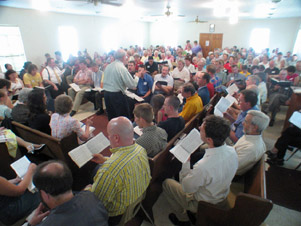 |
 |
||||||||||||
| 1991 Revision. Photo taken by Al Rogers. | Cooper Revision. Photo taken by Al Rogers. | ||||||||||||
 |
 |
||||||||||||
| 1991 Revision. Photo taken by Al Rogers. | Cooper Revision. Photo taken by Al Rogers. | ||||||||||||
Sacred Harp is religious folk music, which is sung with the aid of a unique shape-note songbook, The Sacred Harp, first published in 1844 by B. F. White and E. J. King. Sacred Harp singers produce a quality of sound, which is strangely compelling. Sung a cappella, the music is distinguished by its considerable use of the minor key and its unusual four-part harmony.
Sound Clip from Southwest Texas Convention. Audio by Joshua Martin. Video Clip from East Texas Convention. Video by Gaylon Powell.The Sacred Harp tradition developed out of the singing school movement which began in New England in the late 1700's, then spread to the rural South and finally to Texas. The early singing schools employed the English solemnization technique, which uses syllables "fa, sol, la, mi" to denote the tones of a musical scale.
Developed in the early 1800's by William Smith and William Little, the shape-note method of writing syllables, in which "fa" is represented as a  , "sol" a
, "sol" a  , "la" a
, "la" a  , and "mi" a
, and "mi" a  , made reading notes and recognizing sharps and flats unnecessary.
Combined with the "fasola" technique, shape-notes allowed singing masters to teach people who could not read music how to sing.
[more on the shapes]
, made reading notes and recognizing sharps and flats unnecessary.
Combined with the "fasola" technique, shape-notes allowed singing masters to teach people who could not read music how to sing.
[more on the shapes]
Singers would learn a tune by first "singing the notes" then repeating the song with the lyrics. This custom remains a distinct aspect of Sacred Harp singing, which takes its name from one of the most popular shape-note songbooks.
Monthly singings, which were once held in nearly every community in East and Central Texas, have faded into the past, but several annual singings are still in existence. The East Texas Sacred Harp Singing Convention was organized in 1868, and is the second oldest continuous singing convention in the United States. [more on the singings]
 |
||||||||||||
| Southwest Texas Convention, Spring 2005. Photo by Joshua Martin. |
||||||||||||
The singers sit in a hollow square with space in the middle for the leader. Tenors face altos, and basses face the trebles. The goal is to build a sound and spirit for the singers to enjoy.
The songs are old songs, some 200 and 300 years old. The music has its beginning by oral preservation of singing techniques, rhythms, and melodies from other lands and other times, as well as from the American eighteenth and nineteenth centuries. This oral heritage includes 18th-century revival spirituals, ballads, and dance tunes of colonial America by way of England.
The tune names of the songs are another source of historical interest. The titles of many of the songs are abstractions from the text. But many of the songs go by proper names, following the old English practice of assigning to a song a tune name. [more on the songs]
In recent years, Sacred Harp singing has undergone a revival all over the United States. Regular singings are now held in over 30 states, in Canada, and in The United Kingdom.
 |
 |
 |
 |
 |
 |
 |
 |
||||||||||||||
| texasfasola |
The texasfasola mailing list focuses Sacred Harp Singings for the State of Texas.
The purpose for this list is for the Texas Sacred Harp Singers to communicate with each other concerning announcements of Texas singings, and major events in the Texas singers' lives (such as deaths, serious illness, and births).
To subscribe, send a blank message to texasfasola+subscribe@googlegroups.com |
|
| fasola-singings |
The singings mailing list focuses on traditional fasola singing experiences (and closely related topics) on a national level.
These include such items as announcements of upcoming singings, major events in singers' lives (such as deaths, serious illness, and births), and reports of singing conventions.
To subscribe, send a blank message to fasola-singings+subscribe@googlegroups.com |
|
| fasola-discussions |
The discussions mailing list focuses on historical and technical aspects of shape-note singing.
Examples of topics include tunebook history, shape note pedagogy, musicological analysis, as well as reviews of books, recordings, articles, and conferences.
To subscribe, send a blank message to fasola-discussions+subscribe@googlegroups.com |